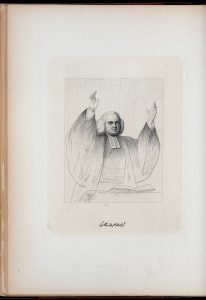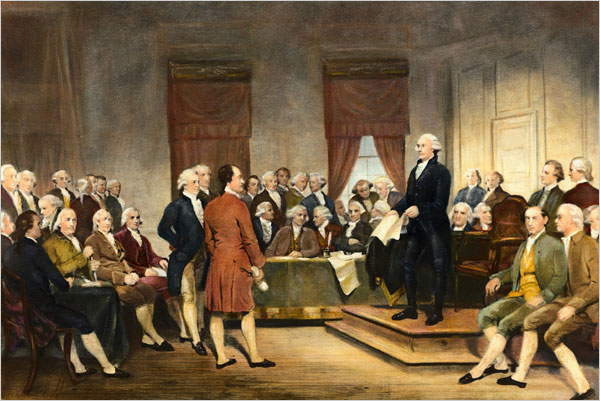1.3 – Pastors Pave the Way for Independence
A Revolution of Hearts & Minds

John Adams, after he had served as both Vice-President and President, penned in 1818 that the Revolution had been won even before the first shot was fired.1 It was won in the minds and hearts of the people emboldened in the spirit of religious liberty that grew out of the Great Awakening that occurred in the colonies between 1730-1770. For four decades, itinerant preachers went throughout the colonies spreading the news of renewed belief in the sovereignty of God and commitment to Biblical living and faith in Jesus Christ, and thousands responded with great enthusiasm. George Whitefield, the most widely traveled and best known of these preachers, had tremendous influence along with Jonathan Edwards, John and Charles Wesley, Samuel Davies, and Charles Chauncy.2
Revival in the Land!
The key to understanding how the Great Awakening impacted the independence movement, is to see how an individual’s change of heart toward God changed their relationship toward one another.
You literally had colonies fighting each other. In Virginia, Christians were killed for not adhering to the established religion. The years leading up to the American Revolution would not have made anyone think that unity was a possibility for the divided colonies. The division between Christian denominations was hard and sharp. God used preachers like John Whitefield during this time to help Americans begin to come together as Christians.
John Adams later recounted to Thomas Jefferson a sermon that Whitefield preached. Adams reminds Jefferson how many times Whitefield preached that sermon and often it was hard. In the sermon, Whitefield told of a dream he had where he died and went to heaven. There he met father Abraham.
Whitefield then said, “Father Abraham, with his hands and eyes gracefully directed to the heavens, as I’ve seen him more than once. Father Abraham, whom have you there with you? Have you Catholics?” “No.”
“Have you Protestants?” “No.”
“Have you churchmen [Anglicans]?” “No.”
“Have you dissenters?” “No.”
“Have you Presbyterians?” “No.”
“Quakers?” “No.”
“Anabaptists?” “No.”
“Whom have you here? Are you alone?” “No.”
“My brethren you have the answer to all these questions in the words of my next text. “He who feareth with God and worketh righteousness shall be accepted of him.” Acts 10:35. “God help us all to forget having names, and to become Christians in deed and in truth.”
John Adams credited Whitefield’s influential sermon with creating a sense of brotherhood and unity among the previously divided colonies.
This revival gave American colonists a new awareness of their accountability to the God of the Bible, not only in their private lives but also their public activities as well. They rediscovered the same universal truth that had motivated the first Pilgrims: that all people, including kings and magistrates at all levels, are equally accountable to God. There is no divine right for officials at any level to arbitrarily rule over the people.3
If we look back to the earliest days of the Pilgrim settlements in the New World, we see how churches, literacy and education set the table for the First Great Awakening. Education of the young was a key part of community life.
As early as 1642, the General Court of Massachusetts Bay Colony was passing education legislation. The so-called “School Law” made it clear that education was a necessary part of a society’s success. It required the teaching of reading, writing, and also required that parents “catechize their children and servants in the grounds & principles of Religion.”
Five years later, the “Old Deluder Satan Law” was passed which said in part, “It being one chief project of that old deluder, Satan, to keep men from the knowledge of the Scriptures…It is therefore ordered that every township in this jurisdiction, after the Lord hath increased them to fifty households shall forthwith appoint one within their town to teach all such children as shall resort to him to write and read…” (see Four Centuries of American Education for more on the Massachusetts school laws)
As new settlements occurred, they were required to establish churches and schools. The stated goal of the school was to teach the next generation to read and study the Bible.4 At the time of the War of Independence, almost 85% of the people were literate, at least to the extent of being able to read their Bibles and a newspaper.5 Twelve of the thirteen colonial colleges founded before the War were instituted to train men for the pulpit ministry.6 Even College graduates who chose the law as a profession were trained equally in theology, since understanding the Bible was considered the beginning point for understanding the law.
The ideas of the Great Awakening spread throughout the colonies in large part through the wide distribution of printed sermons. Ben Franklin enthusiastically printed several of George Whitfield’s sermons.7 Even in small frontier settlements, we find groups gathering together in homes to read some of these great sermons. Whitefield could easily be considered one of America’s Founding Fathers considering the fact that he protested the Stamp Act8 and was one of the earliest advocates for American independence.9
Though not the only factor, in a very real way the Great Awakening served as a spark to the cause of independence. Even though they may have used different modes of worship, people in all parts of the colonies came to understand that they shared the same Judeo-Christian foundation. This rising sense of a shared destiny, founded on Biblical principles, helped lead them out of their colonial isolationist perspective. They began to see the common goal of independence as vital and necessary when the political storms broke out throughout the colonies.
Let us not forget the importance of a remnant in great movements throughout history. God has often used small, seemingly insignificant numbers of people to accomplish great things. Noah and his family, Gideon and his three-hundred, and the remnant that returned to rebuild Jerusalem with Nehemiah are all examples of how God is not limited by small numbers of people. Though estimates vary, when studying the times of the War for American Independence, it is estimated that when the conflict broke out there were approximately 2.5 million people living in the American colonies. Of those 2.5 million, estimates say that only about thirty-five percent favored independence, while another twenty-five percent favored loyalty to the King of England. The approximately 40 percent in the middle were mostly apathetic toward independence, and preferred to simply be left alone.10 Though small in numbers, God used the remnant of patriots in America to bring about a change that has shaped the modern world and brought freedom to countless millions.
Liberty or Death!

The next stop in our time machine finds us just outside St. John’s Church in Richmond, Virginia, in March 1775, just one month before the confrontation at Lexington, Massachusetts. Inside the church, the Virginia House of Burgesses is meeting.11 Patrick Henry, known for his firebrand speeches, is awakening the Virginia House of Burgesses to the rising tensions in Massachusetts, and challenging them to a call to arms.
“If we wish to be free . . . we must fight! An appeal to arms and the God of Hosts is all that is left us! They tell us we are weak . . . shall we gather strength by irresolution and inaction? . . . Sir, we are not weak . . . Three million people armed in the holy cause of liberty and in such a country . . . are invincible to any force that our enemy can send against us. Besides, sir, we shall not fight our battles alone. There is a just God who presides over the destinies of nations; and who will raise up friends to fight our battles for us. The battle is not to the strong alone; it is to the vigilant, the active, the brave . . . Is life so dear or peace so sweet as to be purchased at the price of chains and slavery? Forbid it almighty God! I know not what course others may take, but as for me, give me liberty or give me death!”12
Discover the convergence of Biblical teaching and love of one’s country as you watch the following episode of Chasing American Legends. You will visit two Founding Era churches and learn how their pastors played a critical role in American Independence.
As news of the Battles of Lexington and Concord spread, colonials were beginning to see that these events required action. On May 31, 1775, a provincial convention in Mecklenburg County, NC, passed their own resolutions setting forth the proper relationship between a government and the people.13 Note especially the wording of the second resolution as compared with the Declaration of Independence of 1776.
The Mecklenburg Resolutions
I. Resolved: That whosoever directly or indirectly abets, or in any way, form, or manner countenances the unchartered and dangerous invasion of our rights, as claimed by Great Britain, is an enemy to this country — to America — and to the inherent and inalienable rights of man.
II. Resolved: That we do hereby declare ourselves a free and independent people; are, and of right ought to be a sovereign and self-governing association, under the control of no power, other than that of our God and the General Government of the Congress: To the maintenance of which Independence we solemnly pledge to each other our mutual co-operation, our Lives, our Fortunes, and our most Sacred Honor.
III. Resolved: That as we acknowledge the existence and control of no law or legal officer, civil or military, within this county, we do hereby ordain and adopt as a rule of life, all, each, and every one of our former laws, wherein, nevertheless, the Crown of Great Britain never can be considered as holding rights, privileges, or authorities therein.
IV. Resolved: That all, each, and every Military Officer in this country is hereby reinstated in his former command and authority, he acting to their regulations, and that every Member present of this Delegation, shall henceforth be a Civil Officer, viz: a Justice of the Peace, in the character of a Committee Man, to issue process, hear and determine all matters of controversy, according to said adopted laws, and to preserve Peace, Union, and Harmony in said county, to use every exertion to spread the Love of Country and Fire of Freedom throughout America, until a more general and organized government be established in this Province.
Olive Branch Rejected

As we continue the journey toward independence, let’s check in on the Second Continental Congress convened in Philadelphia, where they have elected John Hancock to be President of the assembly.14 Though still a year away from declaring independence, armed conflict has begun. The Congress appoints George Washington commander of the Continental Army.15 In that same month of June, a major battle is fought just north of Boston, on Bunker’s Hill and Breed’s Hill. While the British technically won the battles after the Americans ran out of ammunition, the British sustained heavy casualties.16
Even after the military engagements of 1775, our Congress still sent an Olive Branch Petition (so called because the olive branch is a symbol of peace) to the king, professing their ties to the crown and hoping for a restoration of relationship.17 This would be America’s final attempt at a resolution after eleven years of British encroachments on American freedom. The king and his government spurned the petition without even reading it and decreed even greater restrictions on the colonies.18
- John Adams, The Works of John Adams, Charles Francis Adams, editor (Boston: Little, Brown, and Company, 1856), Vol. X, pp. 282-289, to H. Niles on February 13, 1818 (at: https://books.google.com/books?id=fWt3AAAAMAAJ&pg=PA282#v=onepage&q&f=false).
- See resources on the First Great Awakening. For example, Joseph Tracy, The Great Awakening. A History of the Revival of Religion in the Time of Edwards and Whitefield (Boston: Charles Tappan, 1845).
- See, for example, sermons on topics such as: the repeal of the Stamp Act (at: https://wallbuilders.com/sermon-stamp-act-repeal-1766/); election sermons such as this one from 1769 (at: https://wallbuilders.com/sermon-election-1769-massachusetts/); a good soldier (at: https://wallbuilders.com/sermon-military-1755/).
- The Code of 1650 (Hartford: Silas Andrus, 1822), pp. 92-94 (at: https://books.google.com/books?id=i3ljAAAAcAAJ&pg=PA92#v=onepage&q&f=false).
- Jack Lynch, ” ‘Every Man Able to Read’ Literacy in Early America,” Colonial Williamsburg, Winter 2011 (at: https://www.history.org/foundation/journal/Winter11_newformat/literacy.cfm)
- See more about the founding of early American colleges in Notes on College Charters (Providence: Brown University, 1910) (at: https://books.google.com/books?id=o_ZBAAAAIAAJ&pg=PA1#v=onepage&q&f=false); Thomas Clap, President of Yale College, Religious Constitutions of Colleges, Especially of Yale-College in New Haven in the Colony of Connecticut (New-London: T. Green, 1754), pp. 1,4 (at: https://books.google.com/books?id=wNUCAAAAQAAJ&pg=PP7#v=onepage&q&f=false).
- A November 15, 1739 notice by Franklin in The Pennsylvania Gazette mentions his intention to publish “journals and sermons” given to him by Whitefield. See: https://founders.archives.gov/documents/Franklin/01-02-02-0052.
- Stephen Mansfield, Forgotten Founding Father: The Heroic Legacy of George Whitefield (Cumberland House, 2001), p. 112.
- George Bancroft, History of the United States from the Discovery of the American Continent (Boston: Little, Brown & Co., 1858), Vol. V, p. 193.
- Calhoon, “Loyalism and neutrality” in Greene and Pole, A Companion to the American Revolution (2000) p. 235. The population of America in 1770 was just over 2.1 million, see “Colonial and Pre-Federal Statistics,” Census Bureau, table on p. 1168 (at: https://www2.census.gov/prod2/statcomp/documents/CT1970p2-13.pdf).
- George Bancroft, History of the United States, From the Discovery of the American Continent (Boston: Little, Brown, and Company, 1858), Vol. VII, p. 272 (https://babel.hathitrust.org/cgi/pt?id=hvd.hn4wau;view=1up;seq=284).
- George Bancroft, History of the United States, From the Discovery of the American Continent (Boston: Little, Brown, and Company, 1858), Vol. VII, pp. 273-274 (https://babel.hathitrust.org/cgi/pt?id=hvd.hn4wau;view=1up;seq=285).
- George Bancroft, History of the United States, From the Discovery of the American Continent (Boston: Little, Brown, and Company, 1858), Vol. VII, pp. 370-373 (https://babel.hathitrust.org/cgi/pt?id=hvd.hn4wau;view=1up;seq=382).
- George Bancroft, History of the United States, From the Discovery of the American Continent (Boston: Little, Brown, and Company, 1858), Vol. VII, pp. 353, 378 (at: https://babel.hathitrust.org/cgi/pt?id=hvd.hn4wau;view=1up;seq=365). For more general information on the Second Continental Congress, see: https://www.ushistory.org/us/10e.asp; https://history.state.gov/milestones/1776-1783/continental-congress.
- George Bancroft, History of the United States, From the Discovery of the American Continent (Boston: Little, Brown, and Company, 1858), Vol. VII, pp. 389-390, 393 (at: https://babel.hathitrust.org/cgi/pt?id=hvd.hn4wau;view=1up;seq=401). See also U.S. Army Center of Military History, “Washington takes command of Continental Army in 1775,” U.S. Army, June 5, 2014 (at: https://www.army.mil/article/40819).
- George Bancroft, History of the United States, From the Discovery of the American Continent (Boston: Little, Brown, and Company, 1858), Vol. VII, pp. 416-435 (at: https://babel.hathitrust.org/cgi/pt?id=hvd.hn4wau;view=1up;seq=428).
- George Bancroft, History of the United States, From the Discovery of the American Continent (Boston: Little, Brown, and Company, 1860), Vol. VIII, pp. 37-38 (at: https://babel.hathitrust.org/cgi/pt?id=hvd.hnjtki;view=1up;seq=41); Journals of the Continental Congress (Washington: Government Printing Offce, 1905), Vol. II, pp. 158-162, July 8, 1775 (at: https://memory.loc.gov/cgi-bin/ampage?collId=lljc&fileName=002/lljc002.db&recNum=157&itemLink=D?hlaw:8).
- George Bancroft, History of the United States, From the Discovery of the American Continent (Boston: Little, Brown, and Company, 1860), Vol. VIII, pp. 130-134 (at: https://babel.hathitrust.org/cgi/pt?id=hvd.hnjtki;view=1up;seq=134).
